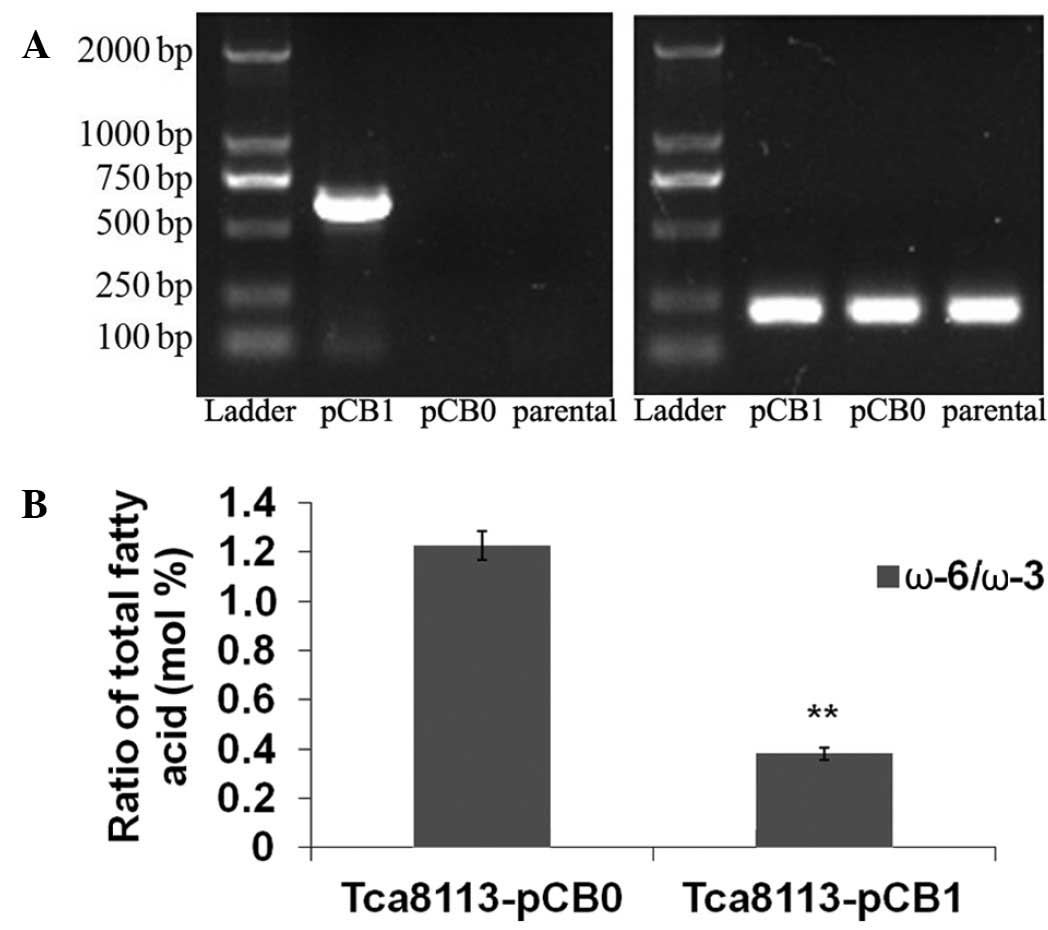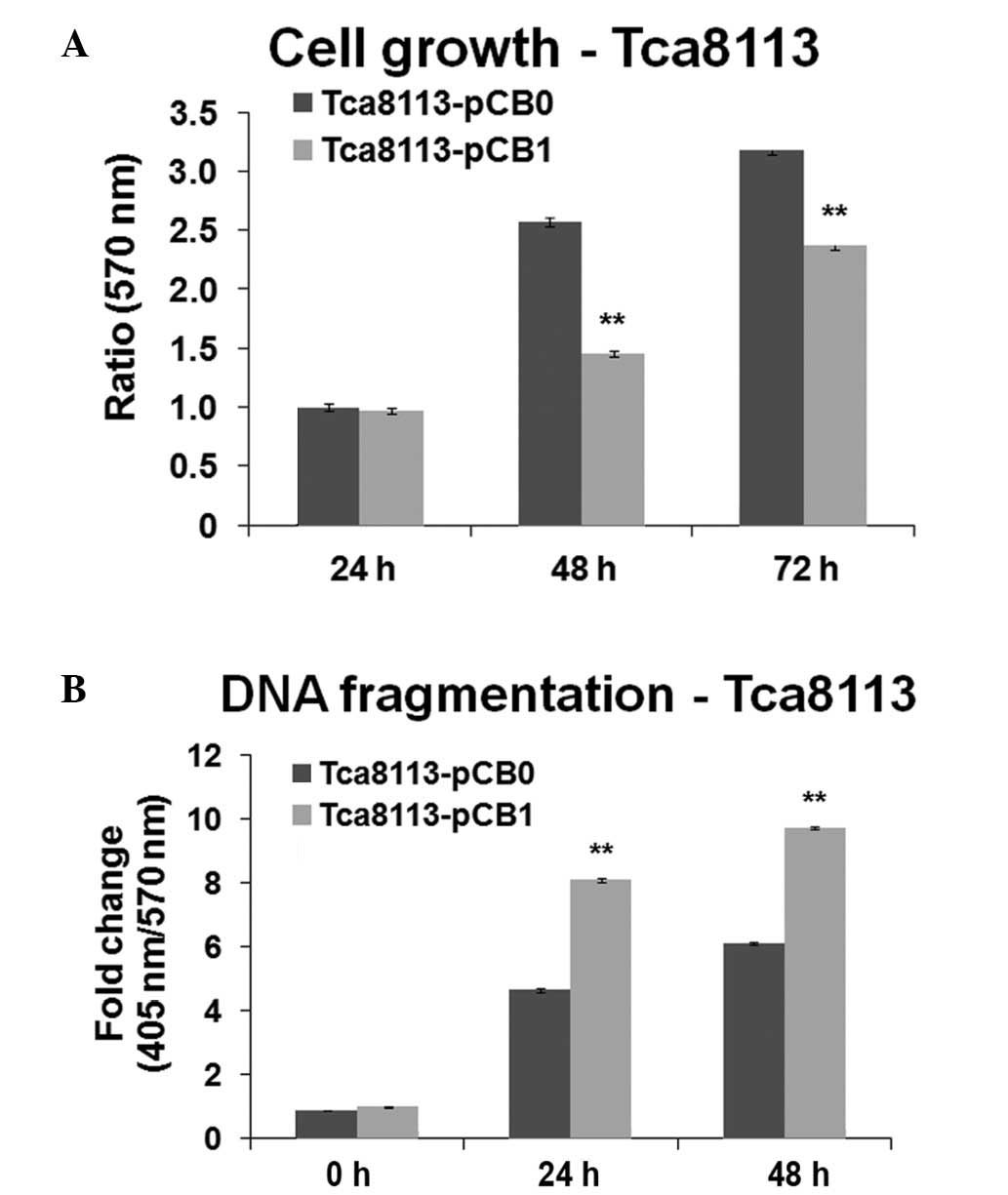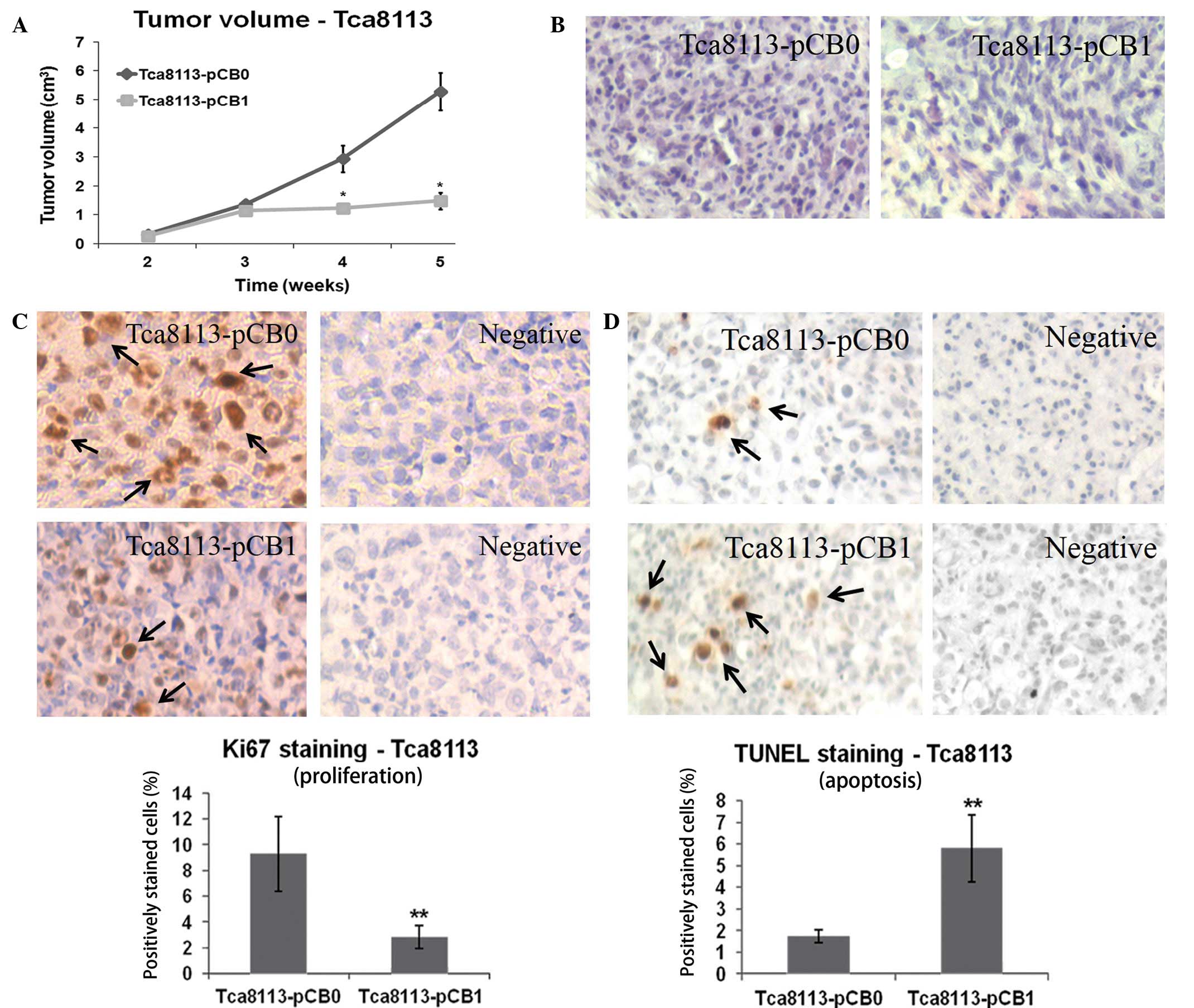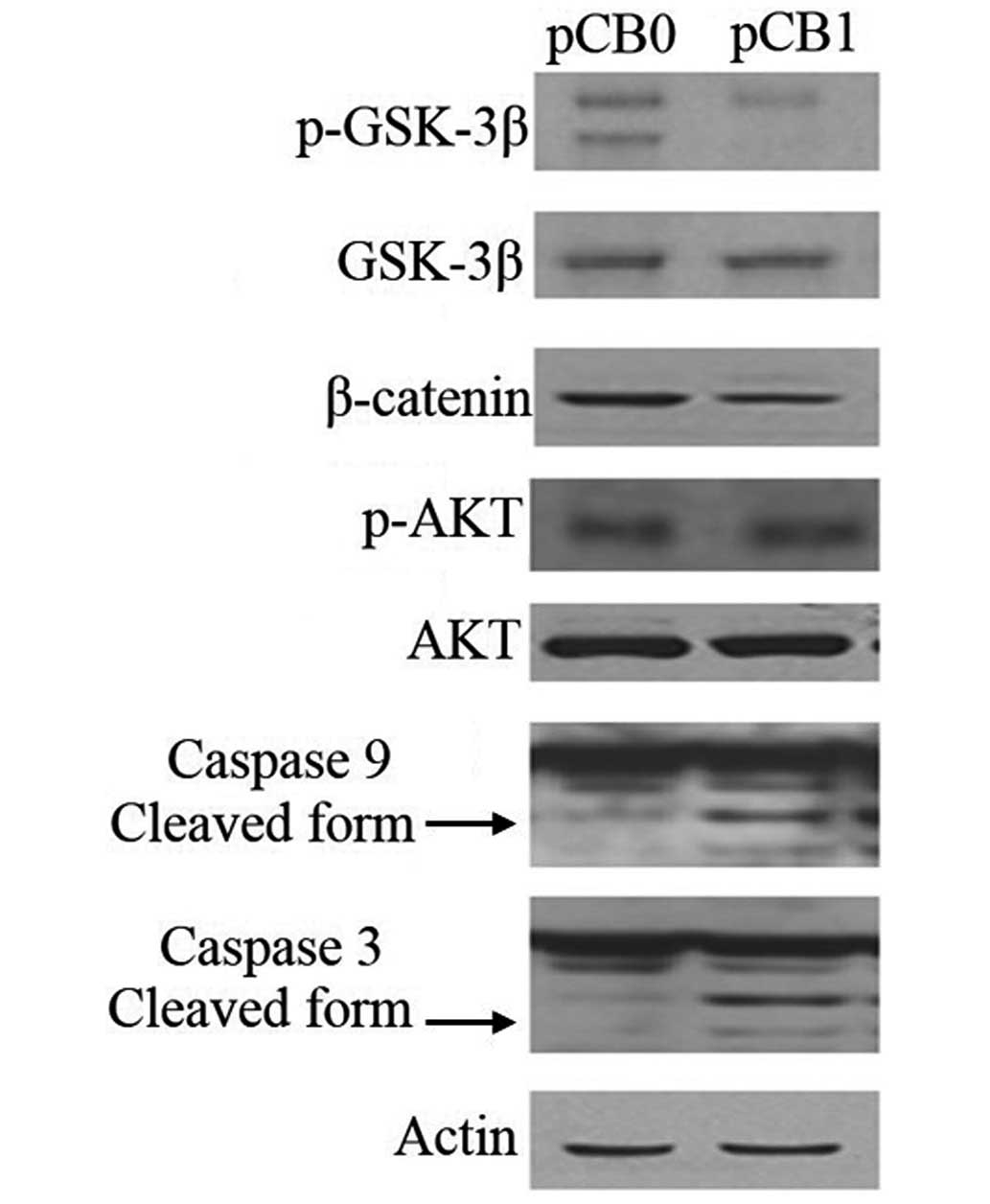Introduction
Oral squamous cell carcinoma (OSCC) has been
established as one of the most common types of cancer worldwide. It
is estimated that in the United States, 3% of cancer cases in men
and 2% in women are OSCC (1).
Recognized risk factors for OSCC include heavy smoking and alcohol
consumption, and current treatment options include surgery and
radiation therapy (2). Patients with
OSCC have a 5-year survival rate of <50% and the treatment of
OSCC has not greatly improved during recent decades (3). Although it has been suggested that OSCC
is a result of accumulated genetic mutations, a clear pathogenetic
pathway for OSCC is yet to be defined (4–6).
Long-chain ω-3 polyunsaturated fatty acids (PUFAs)
have been demonstrated to possess significant chemopreventive
properties and therapeutic potential in the treatment of cancer
(7,8). Dietary intake of ω-3 PUFAs has been
reported to reduce the risk of several malignancies, including
OSCC, by inhibiting the growth of tumors and metastatic lesions
(9). It is suggested that the ratio
of ω-6/ω-3 fatty acids, rather than the absolute levels of the two
PUFAs, is the principal factor that results in the observed
antitumor effects (10–12). In particular, it was reported that
the introduction of the fat-1 gene, which converts ω-6 PUFAs to ω-3
PUFAs, inhibited lung and breast cancer cell growth in vitro
(13,14). In addition to this, it was
demonstrated that melanoma cell growth is reduced in fat-1
transgenic mice (15). However, the
function of the fat-1 gene with regards to OSCC remains unknown.
The present study was designed to evaluate the function and
mechanisms of ω-3 PUFAs and the fat-1 gene (from the C.
elegans worm) in OSCC cells.
Materials and methods
Cell culture
The Tca8113 OSCC cell line was obtained from the
American Type Culture Collection (Rockville, MD, USA). All cells
were cultured in Dulbecco's modified Eagle's medium (DMEM)
supplemented with 10% fetal bovine serum, 100 µg/ml streptomycin
and 100 U/ml penicillin (Invitrogen; Thermo Fisher Scientific,
Inc., Beijing, China). Cells were cultured in 10-cm tissue culture
dishes and maintained in a 37°C incubator equilibrated with 5%
CO2 in humidified air.
Construction of the fat-1 gene
expression vector
The mfat-1 gene was created from the coding region
of the C. elegans fat-1 gene (GenBank: NM_001028389) by
optimizing for mammalian cell expression. The mfat-1 cDNA was
synthesized (Tiangen Biotech Co., Ltd., Beijing, China) and
constructed into the control vector, named pCB0, which is from
pcDNA3.1(+), using restriction enzyme digestion and ligation (NEB,
Beijing, China. The cytomegalovirus (CMV) promoter was replaced
with the CMV immediate-early enhancer/chicken β-actin hybrid
promoter, and the constructed mfat-1 expression vector was named
pCB1.
Transfection of Tca8113 cells
Tca8113 cells were transfected with linearized pCB1
and pCB0 with Lipofectamine Plus reagent (Invitrogen; Thermo Fisher
Scientific, Inc.) according to the manufacturer's protocol. The
cells were then selected with G418 (Invitrogen; Thermo Fisher
Scientific, Inc.) at 350 µg/ml. After 2 weeks of selection, the
G418-resistant colonies were pooled to reduce potential variations
amongst different clones. The mfat-1 transgene expression and
function were confirmed by reverse transcription-polymerase chain
reaction (RT-PCR) and fatty acid profile analysis.
Analysis by RT-PCR
Total RNA was extracted using a SimplyP Total RNA
Extraction kit (Bioer, Beijing, China). Reverse transcription was
performed using random hexamer oligonucleotide primers using the
BioRT Two-Step RT-PCR kit (Bioer) according to the manufacturer's
protocol. Cells were then subjected to RT-PCR for the detection of
mfat-1 mRNA expression. The sequences of the primers of mfat-1 were
as follows: Sense 5′-CCGCCACCGCTCCCGTCAC-3′ and antisense
5′-TGCTTCCCAATCCTTAT-3′. The resulting amplification product was
527 bp in length. PCR primers for GAPDH were as follows: Sense
5′-CCATGGAGAAGGCTGGGG-3′ and antisense 5′-CAAAGTTGTCATGGATGACC-3′.
GAPDH was used as the control, and the resulting amplification
product was 194 bp. The PCR amplification was performed at 95°C for
30 sec, 60°C for 30 sec and 72°C for 30 sec for 30 cycles, with a
final extension at 72°C for 6 min. The PCR products were separated
on a 1.0% agarose gel (Tiangen Biotech Co., Ltd.) at 120 V and
stained with ethidium bromide (Tiangen Biotech Co., Ltd.).
Gas chromatography
Lipids were extracted from the cells according to
the technique of Bligh and Dyer (16). Briefly, the samples were homogenized
in a mixture of methanol, chloroform, and water. After 15 min,
chloroform was added and the samples were vortexed and centrifuged
at 1,500 × g for 30 min. The lower phase was dried under nitrogen
and resuspended in boron trifluoride methanol (Sigma-Aldrich, St.
Louis, MO, USA). The samples were heated at 90°C for 30 min and
extracted with 4.0 ml pentane (Beijing Chemical Works, Beijing,
China) and 1.5 ml water. The mixtures were then vortexed and the
upper phase was recovered. The extracts were dried, resuspended in
heptane (Sigma-Aldrich), and injected into a capillary column
(SP-2380, 105 m × 53 mm ID, 0.20-µm film thickness; Sigma-Aldrich).
The gas chromatograph was performed on a Clarus 500 gas
chromatograph (PerkinElmer, Inc., Waltham, MA, USA). The comparison
of retention time to authentic standards (Sigma-Aldrich) were used
to identify components.
MTT cell proliferation assay
Briefly, Tca8113 cells and the cells transfected
with either pCB1 and pCB0 were plated in 96-well plates overnight.
A density of 3,000 cells/well in 200 µl appropriate growth media
was used, and these cells were incubated for 24, 48 and 72 h. Next,
20 µl/well MTT solution (Invitrogen; Thermo Fisher Scientific,
Inc.) was added and the cells were incubated for another 3.5 h. The
absorbance of each well at 570 nm, with the background subtraction
at 650 nm, was read by a Multiskan GO Microplate Spectrophotometer
(Thermo Fisher Scientific, Inc., Waltham, MA, USA). The average
absorbance of 6 wells/experiment was used.
DNA fragmentation analysis
Apoptosis was detected and quantified by the Cell
Death Detection ELISAPLUS kit (Roche Diagnostics,
Shanghai, China). Briefly, cells were seeded in plates with a
regular medium and allowed to grow until 70–80% confluent. Next,
cells were washed twice with PBS and the regular media was changed
to DMEM without serum. DNA fragmentation was calculated by the fold
change and normalized with corresponding MTT results from identical
culture conditions.
Xenograft model
To establish xenografts in nude mice, Tca8113 cells
that were transfected with either pCB1 or pCB0 in log-phase growth
were washed twice with PBS and then counted. Subcutaneous tumors
were established by injecting 1.2×106 Tca8113 cells,
which were resuspended in 200 µl PBS, onto each side of the dorsal
surface on the BALB/c nude male mice. Six-week-old male BALB/c nude
mice were obtained from Model Animal Research Center of Nanjing
University (Nanjing, China). Mice were assigned to two groups (n=6
per group): Tca8113-pCB0 or Tca8113-pCB1, and were handled in
accordance to institutional guidelines for animal care. The tumor
size was measured once weekly for 5 weeks and the tumor volume
(mm3) was calculated as follows: Tumor volume =
LxW2×0.5. The tumor volume data were subjected to
statistical analysis using either the Student's two-tailed t-test
or the Mann-Whitney U test. The animal experiments were performed
according to the protocol approved by the Jilin University
Institutional Animal Care and Use Committee (#2012079; Changchun,
China).
Immunostaining
Xenograft tumors were harvested and placed in 10%
formalin, embedded in paraffin, and sectioned at 5 µm thickness
using an RM2255 microtome (Leica Microsystems, Inc., Buffalo Grove,
IL, USA). Paraffin-embedded tumor blocks were cut at serial
sections and the obtained slides were used for hematoxylin and
eosin (H&E) staining and immunohistochemical analysis, as
described by Lu et al (17).
Tumor cell proliferation was studied by immunostaining with a Ki-67
antibody (#PA121520; Invitrogen; Thermo Fisher Scientific, Inc.).
Similarly, apoptosis was detected using an Apoptag terminal
deoxynucleotidyl-transferase-mediated dUTP nick end labeling
(TUNEL) assay kit (EMD Millipore, Billerica, MA, USA),
counterstained with methyl green (Sigma-Aldrich). The rates of
proliferation and apoptosis were quantitatively determined by
counting the percentage of positively stained cell bodies from
three histologically similar fields viewed at ×400 magnification
using a Labophot-2 microscope (Nikon Corporation, Tokyo, Japan),
which were randomly selected from each slide. Slides of 3 fields
per animal and 5 animals per group were used for comparison.
Immunoblotting
Cell samples were measured for total protein
concentration using the bicinchoninic acid (BCA) assay (Pierce
Biotechnology, Inc., Rockford, IL, USA). A total of 40 µg
protein/samples were prepared and separated on 12% SDS-PAGE gels at
100 V prior to transfer to polyvinylidine difluoride membranes
(Bio-Rad Laboratories, Inc., Beijing, China). The membranes were
blocked and shaken at room temperature for 1 h and then incubated
overnight with rabbit anti-mouse primary antibodies against
caspase-3 (#9662), caspase-9 (#9504), GSK-3β (#9315), p-GSK-3β
(#9322), β-catenin (#9562), Akt (#9272) and p-Akt (#9275; Cell
Signaling Technology, Inc., Danvers, MA, USA), all at a dilution of
1:1,000. The next day, the blots were washed 3 times with
PBS-Tween-20 (PBS-T), then incubated with the corresponding goat
anti-rabbit polyclonal horseradish peroxidase-conjugated secondary
antibodies (1:5,000: #12348; Sigma-Aldrich) for 1 h at room
temperature. Following another 3 washes with PBS-T, the blots were
subjected to the ECL Western blotting detection reagents and
analysis system (GE Healthcare Life Sciences, Piscataway, NJ, USA)
to visualize the protein bands.
Statistical analysis
Statview software, version 4.5 (Abacus Concepts,
Berkley, CA, USA) was used for the statistical analysis. Analysis
of variance was used for initial analysis, followed by Fisher's
protected least significant difference for post hoc
analyses. All experiments were performed at least in triplicate and
the results are presented as the mean ± standard deviation.
P<0.05 was considered to indicate a statistically significant
difference.
Results
Expression of the mfat-1 gene
decreased the ratio of ω-6/ω-3 PUFAs
Following transfection of the Tca8113 cells with the
mfat-1 gene (pCB1), RT-PCR with mfat-1-specific primers indicated
that the cells transfected with pCB1 expressed high levels of the
mfat-1 gene (Fig. 1A). As expected,
the mfat-1 gene was not expressed in the parental cells or the
cells that were transfected with the control vector (pCB0). To
analyze the function of the mfat-1 gene, gas chromatography was
performed to assess the composition of PUFAs in the cells. The
level of ω-3 PUFAs was significantly increased in cells transfected
with pCB1, compared with cells transfected with pCB0 (Table I). The level of PUFAs in cells
transfected with pCB1 and pCB0 are presented in Table I as a percentage of the total
cellular lipids. The expression of the mfat-1 gene led to a
significant increase in ω-3 PUFAs, accompanied by a decrease in ω-6
PUFAs (Table I). The ratio of
ω-6/ω-3 PUFAs with or without exogenous mfat-1 were 0.381 and
1.275, respectively (P<0.001; Fig.
1B). This indicates that the expression of mfat-1 can convert
ω-6 PUFAs into the corresponding ω-3 forms. It can be predicted
that the change in the ω-6/ω-3 PUFA ratio affects the endogenous
ω-3 PUFA production mechanism, while reducing the level of ω-6 PUFA
production.
 | Table I.PUFA composition of total cellular
lipids from the cells that were transfected with the mfat-1 cDNA or
the control vector. |
Table I.
PUFA composition of total cellular
lipids from the cells that were transfected with the mfat-1 cDNA or
the control vector.
| % of total fatty
acid | Tca8113-pCB1 | Tca8113-pCB0 |
|---|
| ω-6
polyunsaturates |
|
|
| 18:2 | 7.68 | 4.31 |
| 20:4 | 10.88 | 16.95 |
|
Total | 18.56 | 20.96 |
| ω-3
polyunsaturates |
|
|
| 18:3 | 1.62 | 0.32 |
| 20:5 | 22.58 | 2.29 |
| 22:5 | 13.86 | 4.68 |
| 22:6 | 10.61 | 9.15 |
|
Total | 48.67 | 16.44 |
| ω-3/ω-6 ratio | 0.38a | 1.27 |
Expression of the mfat-1 gene
decreased cell growth and increased apoptosis in vitro
To determine whether the change in the ratio of
ω-6/ω-3 PUFAs in Tca8113 cells inhibits tumor cell proliferation
in vitro, cells were cultured for different time periods and
MTT cell proliferation assays were performed. Expression of the
mfat-1 gene significantly inhibited the Tca8113 cell proliferation
in cells that were transfected with pCB1, compared with the cells
that transfected with pCB0 at 48 and 72 h (P<0.001; Fig. 2A). To evaluate whether mfat-1 gene
expression in Tca8113 cells promotes programmed cell death, a DNA
fragmentation ELISA assay was performed. The results demonstrated
that mfat-1 gene expression enhances apoptosis in Tca8113 cells at
24 and 48 h, compared with cells transfected with the control
vector (P<0.001; Fig. 2B).
Expression of the mfat-1 gene
inhibited tumor growth in vivo
To determine the antitumor effect of the mfat-1 gene
in vivo, Tca8113 cells transfected with either pCB1 or pCB0
were implanted into nude mice. The cells were allowed 5 weeks for
tumor growth. The results in Fig. 3
demonstrate that mfat-1 gene expression significantly reduces
Tca8113 cell tumor volume at 4 and 5 weeks subsequent to
implantation, compared with cells that were transfected with the
control vector (P<0.05; Fig.
3A).
Expression of the mfat-1 gene reduced
the number of viable Tca8113 cells and increased necrosis
To determine the mechanism of tumor growth
inhibition by the mfat-1 gene, histological analyses were
performed. H&E staining demonstrated that the overexpression of
the mfat-1 gene was associated with a reduced number of viable
cells and an increased area of necrosis (Fig. 3B). The number of proliferating cells,
identified by Ki-67-positive nuclei, was significantly reduced in
the tumor cells transfected with the mfat-1 gene compared with the
control-transfected cells (P<0.001; Fig. 3C). It was also observed, using a
TUNEL assay, that the introduction of the mfat-1 gene to Tca8113
cells was associated with an increased number of positively stained
apoptotic cells. Cell counts indicated that 50–60% of cells
transfected with the mfat-1 gene were apoptotic, whereas 10–20% of
cells were apoptotic in the control group, and this difference was
demonstrated to be statistically significant (P<0.001; Fig. 3D).
Expression of the mfat-1 gene induced
caspase-3-mediated cell apoptosis and inhibited Tca8113 cell
proliferation
To further investigate the mechanism of mfat-1 gene
expression on the inhibition of tumor cell growth, the protein
expression of caspase-3, caspase-9, p-GSK-3β, GSK-3β, β-catenin,
p-Akt and Akt was examined (Fig. 4).
It was demonstrated that the cleavage of caspase-9 and caspase-3
was enhanced in cells transfected with the mfat-1 gene, and
mfat-1-transfected cells presented a reduced level of GSK-3β
phosphorylation and β-catenin expression. No alterations were
observed in Akt expression or phosphorylation.
Discussion
Previous experimental data have demonstrated that
the ω-3 fatty acids antagonize the stimulative roles of ω-6 fatty
acids in carcinogenesis, tumor growth and metastasis (10,13,17). In
the current study, in vitro and in vivo models were
used to evaluate the effect of ω-3 PUFAs on Tca8113 cell growth. A
codon-optimized C. elegans gene, mfat-1, encoding the enzyme
ω-3 fatty acid desaturase, was transfected into Tca8113 cells.
Since this enzyme converts endogenous ω-6 PUFAs into the
corresponding ω-3 forms, there is no requirement for a traditional,
lengthy feeding regimen to achieve stable increases in cellular ω-3
PUFAs. This model serves as a good platform for the analysis of the
effect of ω-3 PUFAs on the proliferation and viability of OSCC
cells. The present study confirms that mfat-1 expression increases
the level of ω-3 PUFAs and decreases the level of ω-6 PUFAs in OSCC
cells. Additionally, the study demonstrated that mfat-1 expression
inhibits cell proliferation and enhances cell apoptosis in
vitro. To investigate the feasibility of using an mfat-1
transgene as a potential therapeutic approach, mfat-1-transfected
OSCC cells were implanted into athymic nude mice and the tumor
volume was monitored for 5 weeks. It was demonstrated that mfat-1
gene expression reduced tumor growth in vivo via the
induction of apoptosis and the inhibition of cell proliferation. It
can therefore be hypothesized that ω-3 PUFAs may have
chemopreventive and antitumorigenic effects.
With regards to the mechanism underlying the
antitumor effects of the mfat-1 gene in OSCC cells, it was observed
that mfat-1 expression reduces GSK3β phosphorylation and the
expression of β-catenin. β-catenin is a key molecule in the Wnt
signaling pathway, and serves a significant role in the regulation
of multiple cellular functions in embryogenesis and tumorigenesis
(18). Wnt proteins are a large
family of secreted glycoproteins that have been reported to be
responsible for the activation of multiple pathways, including the
canonical Wnt pathway through β-catenin, the non-canonical Wnt
pathway through planar cell polarity, and the Wnt-Ca2+
pathway (19). In particular, the
canonical Wnt pathway requires the stabilization of β-catenin
(18). However, in the absence of a
Wnt signal, β-catenin resides within the cytosol in the form of a
β-catenin destruction complex, where it is phosphorylated and
destined for proteasome-dependent degradation (20). Upon the activation of Wnt signaling,
this β-catenin destruction complex separates, resulting in the
cytoplasmic accumulation of β-catenin followed by its translocation
into the nucleus (21,22). β-catenin then associates with T-cell
factor/lymphoid enhancer factor transcription factors in the
nucleus and stimulates the transcription of target genes involved
in cell proliferation, differentiation and apoptosis (23,24). The
dysregulation of the Wnt-β-catenin signaling pathway has been
reported in several types of cancer in humans, including multiple
myeloma (25) and gastrointestinal
cancer (26). However, its
implications in oral cancer remain uncertain. The present study
suggests that the overexpression of the mfat-1 gene in OSCC cells
inhibits cell proliferation through the inhibition of the
Wnt/β-catenin signaling pathway.
In summary, the current study describes preclinical
evidence for the use of mfat-1 and ω-3 PUFAs in the chemoprevention
and treatment of OSCC.
Acknowledgements
The present work was supported by the Youth
Foundation of the Jilin Science and Technology Commission (grant
no. 3D512J526604).
References
|
1
|
Lambert R, Sauvaget C, de Camargo Cancela
M and Sankaranarayanan R: Epidemiology of cancer from the oral
cavity and oropharynx. Eur J Gastroenterol Hepatol. 23:633–641.
2011. View Article : Google Scholar : PubMed/NCBI
|
|
2
|
Bhide SA, Ahmed M, Newbold K, Harrington
KJ and Nutting CM: The role of intensity modulated radiotherapy in
advanced oral cavity carcinoma. J Cancer Res Ther. 8(Suppl 1):
S67–S71. 2012.PubMed/NCBI
|
|
3
|
Khan Z and Bisen PS: Oncoapoptotic
signaling and deregulated target genes in cancers: Special
reference to oral cancer. Biochim Biophys Acta. 1836:123–145.
2013.PubMed/NCBI
|
|
4
|
Braakhuis BJ, Leemans CR and Brakenhoff
RH: A genetic progression model of oral cancer: Current evidence
and clinical implications. J Oral Pathol Med. 33:317–322. 2004.
View Article : Google Scholar : PubMed/NCBI
|
|
5
|
Califano J, van der Riet P, Westra W,
Nawroz H, Clayman G, Piantadosi S, Corio R, Lee D, Greenberg B,
Koch W and Sidransky D: Genetic progression model for head and neck
cancer: Implications for field cancerization. Cancer Res.
56:2488–2492. 1996.PubMed/NCBI
|
|
6
|
Choi S and Myers JN: Molecular
pathogenesis of oral squamous cell carcinoma: Implications for
therapy. J Dent Res. 87:14–32. 2008. View Article : Google Scholar : PubMed/NCBI
|
|
7
|
Hardman WE: (n-3) fatty acids and cancer
therapy. J Nutr. 134(Suppl): 3427S–3430S. 2004.PubMed/NCBI
|
|
8
|
Larsson SC, Kumlin M, Ingelman-Sundberg M
and Wolk A: Dietary long-chain n-3 fatty acids for the prevention
of cancer: A review of potential mechanisms. Am J Clin Nutr.
79:935–945. 2004.PubMed/NCBI
|
|
9
|
Nikolakopoulou Z, Nteliopoulos G,
Michael-Titus AT and Parkinson EK: Omega-3 polyunsaturated fatty
acids selectively inhibit growth in neoplastic oral keratinocytes
by differentially activating ERK1/2. Carcinogenesis. 34:2716–2725.
2013. View Article : Google Scholar : PubMed/NCBI
|
|
10
|
Gago-Dominguez M, Yuan JM, Sun CL, Lee HP
and Yu MC: Opposing effects of dietary n-3 and n-6 fatty acids on
mammary carcinogenesis: The Singapore Chinese Health Study. Br J
Cancer. 89:1686–1692. 2003. View Article : Google Scholar : PubMed/NCBI
|
|
11
|
Maillard V, Bougnoux P, Ferrari P, Jourdan
ML, Pinault M, Lavillonnière F, Body G, Le Floch O and Chajès V:
N-3 and N-6 fatty acids in breast adipose tissue and relative risk
of breast cancer in a case-control study in Tours, France. Int J
Cancer. 98:78–83. 2002. View Article : Google Scholar : PubMed/NCBI
|
|
12
|
Simonsen N, van't Veer P, Strain JJ,
Martin-Moreno JM, Huttunen JK, Navajas JF, Martin BC, Thamm M,
Kardinaal AF, Kok FJ and Kohlmeier L: Adipose tissue omega-3 and
omega-6 fatty acid content and breast cancer in the EURAMIC study.
European Community Multicenter Study on Antioxidants, Myocardial
Infarction, and Breast Cancer. Am J Epidemiol. 147:342–352. 1998.
View Article : Google Scholar : PubMed/NCBI
|
|
13
|
Xia SH, Wang J and Kang JX: Decreased
n-6/n-3 fatty acid ratio reduces the invasive potential of human
lung cancer cells by downregulation of cell
adhesion/invasion-related genes. Carcinogenesis. 26:779–784. 2005.
View Article : Google Scholar : PubMed/NCBI
|
|
14
|
Ge Y, Chen Z, Kang ZB, Cluette-Brown J,
Laposata M and Kang JX: Effects of adenoviral gene transfer of
C. elegans n-3 fatty acid desaturase on the lipid profile
and growth of human breast cancer cells. Anticancer Res. 22(2A):
537–543. 2002.PubMed/NCBI
|
|
15
|
Xia S, Lu Y, Wang J, He C, Hong S, Serhan
CN and Kang JX: Melanoma growth is reduced in fat-1 transgenic
mice: Impact of omega-6/omega-3 essential fatty acids. Proc Natl
Acad Sci USA. 103:12499–12504. 2006. View Article : Google Scholar : PubMed/NCBI
|
|
16
|
Bligh EG and Dyer WJ: A rapid method of
total lipid extraction and purification. Can J Biochem Physiol.
37:911–917. 1959. View
Article : Google Scholar : PubMed/NCBI
|
|
17
|
Lu Y, Nie D, Witt WT, Chen Q, Shen M, Xie
H, Lai L, Dai Y and Zhang J: Expression of the fat-1 gene
diminishes prostate cancer growth in vivo through enhancing
apoptosis and inhibiting GSK-3 beta phosphorylation. Mol Cancer
Ther. 7:3203–3211. 2008. View Article : Google Scholar : PubMed/NCBI
|
|
18
|
Veeman MT, Axelrod JD and Moon RT: A
second canon. Functions and mechanisms of beta-catenin-independent
Wnt signaling. Dev Cell. 5:367–377. 2003. View Article : Google Scholar : PubMed/NCBI
|
|
19
|
Bovolenta P, Rodriguez J and Esteve P:
Frizzled/RYK mediated signalling in axon guidance. Development.
133:4399–4408. 2006. View Article : Google Scholar : PubMed/NCBI
|
|
20
|
Clevers H: Wnt/beta-catenin signaling in
development and disease. Cell. 127:469–480. 2006. View Article : Google Scholar : PubMed/NCBI
|
|
21
|
Gordon MD and Nusse R: Wnt signaling:
Multiple pathways, multiple receptors, and multiple transcription
factors. J Biol Chem. 281:22429–22433. 2006. View Article : Google Scholar : PubMed/NCBI
|
|
22
|
Hoppler S and Kavanagh CL: Wnt signalling:
Variety at the core. J Cell Sci. 120:385–393. 2007. View Article : Google Scholar : PubMed/NCBI
|
|
23
|
Lim K, Han C, Dai Y, Shen M and Wu T:
Omega-3 polyunsaturated fatty acids inhibit hepatocellular
carcinoma cell growth through blocking beta-catenin and
cyclooxygenase-2. Mol Cancer Ther. 8:3046–3055. 2009. View Article : Google Scholar : PubMed/NCBI
|
|
24
|
Moon RT, Kohn AD, De Ferrari GV and Kaykas
A: WNT and beta-catenin signalling: Diseases and therapies. Nat Rev
Genet. 5:691–701. 2004. View
Article : Google Scholar : PubMed/NCBI
|
|
25
|
Chim CS, Pang R, Fung TK, Choi CL and
Liang R: Epigenetic dysregulation of Wnt signaling pathway in
multiple myeloma. Leukemia. 21:2527–2536. 2007. View Article : Google Scholar : PubMed/NCBI
|
|
26
|
White BD, Chien AJ and Dawson DW:
Dysregulation of Wnt/β-catenin signaling in gastrointestinal
cancers. Gastroenterology. 142:219–232. 2012. View Article : Google Scholar : PubMed/NCBI
|


















